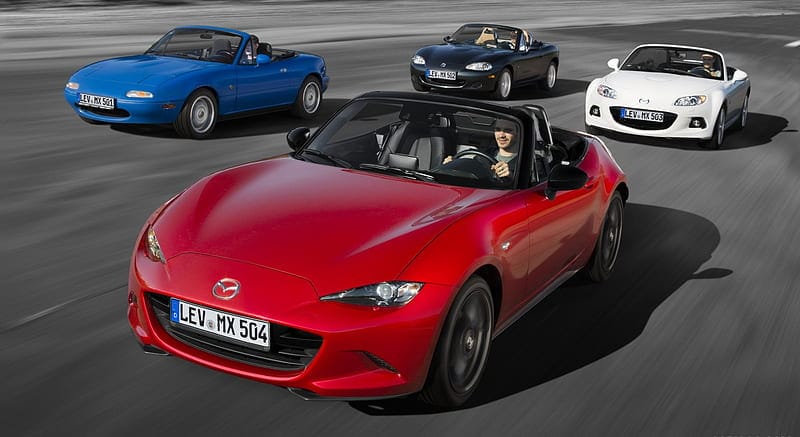Miata’s Influence on Sports Car Racing
Sports car racing has long been a thrilling and captivating domain for enthusiasts and professionals alike. Among the many iconic vehicles that have left a significant mark on this high-octane world, the Mazda Miata stands out as a game-changer. Since its inception, the Miata has not only reshaped t

Sports car racing has long been a thrilling and captivating domain for enthusiasts and professionals alike. Among the many iconic vehicles that have left a significant mark on this high-octane world, the Mazda Miata stands out as a game-changer. Since its inception, the Miata has not only reshaped the landscape of sports car design and performance but has also played a pivotal role in the growth of amateur and professional racing scenes. In this blog post, we delve into the profound influence of the Miata on sports car racing, exploring its impact on design, performance, accessibility, and the future of racing. Join us as we trace the genesis of Miata in the sports car scene and uncover its enduring legacy in motorsport.
The Genesis of Miata in the Sports Car Scene
The Mazda Miata, also known as the MX-5 or Eunos Roadster in certain markets, made its debut in 1989 and quickly captured the hearts of sports car enthusiasts around the world. Its genesis can be traced back to Mazda’s desire to revive the spirit of classic lightweight British roadsters of the 1960s, such as the Lotus Elan and the MG Midget. The goal was to create an affordable, fun-to-drive sports car that would reignite the passion for open-top motoring
Mazda’s team of engineers and designers embarked on a mission to create a modern interpretation of the classic roadster. They focused on key principles such as lightweight construction, balanced handling, and driver engagement. The result was the Mazda Miata, a two-seater convertible that perfectly captured the essence of a pure sports car.

The Miata’s design paid homage to its British predecessors, with its long hood, short rear deck, and a low-slung silhouette. It featured a manually operated soft-top, emphasizing the joy of open-air driving. The interior was purposefully minimalistic, with a driver-centric cockpit and well-placed controls, enhancing the connection between the driver and the car.

Upon its release, the Miata garnered immediate acclaim for its striking design and exhilarating driving dynamics. It offered a level of driving pleasure that had been missing from the market for years, and quickly became a symbol of the renaissance of sports car racing.
With its affordable price tag, the Miata became accessible to a wide range of enthusiasts, from seasoned racers to first-time sports car owners. This democratization of sports car ownership played a crucial role in the Miata’s influence on the sports car racing scene, as it opened the doors for aspiring racers and enthusiasts to experience the thrill of competition.

In the next sections, we will explore how the Miata’s design and performance revolutionized sports car racing and examine its impact on the growth of both amateur and professional racing circuits.
Miata’s Impact on the Design and Performance of Sports Cars
The influence of the Mazda Miata extends far beyond its captivating design and nostalgic appeal. The Miata’s impact on the design and performance of sports cars is undeniable, as it introduced several groundbreaking innovations that have shaped the industry. In this section, we will explore how the Miata pioneered lightweight design, influenced performance metrics, and inspired other manufacturers to adopt its design principles.
How Miata Pioneered Lightweight Design
One of the key factors that contributed to the Miata’s exceptional handling and agility was its emphasis on lightweight construction. Mazda engineers employed various techniques to reduce weight, such as utilizing aluminum components, adopting a simple and compact design, and implementing innovative manufacturing processes. By prioritizing lightweight materials and components, the Miata achieved a favorable power-to-weight ratio, enabling it to deliver unparalleled responsiveness and precision on the road and the racetrack.

Miata’s Influence on Performance Metrics
The Miata challenged the notion that sports cars needed immense horsepower to deliver thrilling performance. Instead, it focused on optimizing other performance metrics, such as balance, agility, and driver engagement. The perfectly balanced weight distribution, low center of gravity, and responsive steering of the Miata contributed to its remarkable handling characteristics. This approach to performance metrics revolutionized the sports car industry, proving that a car’s performance could be measured beyond sheer power.
Adoption of Miata’s Design Principles by Other Manufacturers
The success of the Miata sparked a wave of admiration and inspiration among other automakers. Many manufacturers recognized the effectiveness of the Miata’s design principles and sought to incorporate similar elements into their own sports car models. This led to the emergence of a new generation of lightweight, nimble, and driver-focused sports cars across various brands. The influence of the Miata can be seen in the design and performance characteristics of these vehicles, as they aimed to capture the essence of what made the Miata so beloved by enthusiasts.

In the next sections, we will delve deeper into the Miata’s role in the growth of amateur and professional sports car racing, exploring how it promoted accessibility, its presence in professional racing circuits, and the inspiring careers it launched.
Miata’s Role in the Growth of Amateur and Professional Sports Car Racing
The Mazda Miata has played a significant role in the growth and development of both amateur and professional sports car racing. Its accessibility, affordability, and exceptional performance have made it a popular choice among racing enthusiasts, paving the way for new opportunities and attracting a diverse range of individuals to the world of motorsport.
Promoting Accessibility in Racing
One of the defining features of the Miata is its affordability, making it an attractive option for aspiring racers who may have previously found motorsport to be financially out of reach. The relatively low cost of purchasing and maintaining a Miata has significantly lowered the barrier to entry for amateur racing. This accessibility has allowed a broader range of individuals to participate in motorsport, contributing to the growth and diversity of the racing community.

Miata’s Presence in Professional Racing Circuits
The Miata’s success and reputation in amateur racing have also translated into its presence in professional racing circuits. Mazda recognized the potential of the Miata as a competitive racing platform and developed various racing series and championships specifically for the model. The Global MX-5 Cup, for example, showcases the talents of professional drivers competing in identically prepared Miata race cars. This professional racing exposure has elevated the Miata’s profile and solidified its position as a respected contender in the world of motorsport.

How Miata Inspired a New Generation of Racers
The Miata’s impact extends beyond its role as a race car. Its engaging driving experience and accessible nature have inspired a new generation of racers, igniting a passion for motorsport among young enthusiasts. The Miata’s community-driven culture, grassroots racing events, and supportive network of fellow enthusiasts have fostered a sense of camaraderie and mentorship, nurturing the development of aspiring racers. Many successful racing careers have been launched thanks to the Miata’s influence, serving as a testament to its ability to inspire and shape the future of motorsport.
In the next section, we will explore the future of the Miata in sports car racing, examining emerging trends, innovations in Miata design, and its role in the era of electric and autonomous racing.
The Future of Miata in Sports Car Racing
The Mazda Miata has a rich history in sports car racing, but its influence and impact are far from over. As we look to the future, it is important to consider the evolving landscape of motorsport and the role that the Miata will play in shaping the future of sports car racing. In this final section, we will explore emerging trends, innovations in Miata design, and the Miata’s role in the era of electric and autonomous racing.
Emerging Trends and Innovations in Miata Design
The automotive industry is constantly evolving, with new technologies and design concepts shaping the future of sports cars. As we move forward, it is expected that the Miata will continue to adapt and incorporate these advancements. This may include improvements in aerodynamics, materials, and drivetrain technologies to enhance performance, efficiency, and safety. Additionally, the Miata’s design may evolve to meet changing aesthetic preferences and incorporate futuristic elements while staying true to its iconic heritage.

Miata’s Role in the Era of Electric and Autonomous Racing
The future of sports car racing is increasingly being shaped by advancements in electric and autonomous technologies. As the industry moves towards a more sustainable and connected future, the Miata is likely to embrace these changes. We may see the introduction of electric-powered Miata models, offering environmentally friendly performance and zero-emission racing capabilities. Additionally, the Miata’s adaptability and versatility may lend itself to autonomous racing, where human drivers are replaced by advanced artificial intelligence systems.

How Miata Continues to Shape the Future of Racing
Regardless of the specific changes and advancements that lie ahead, one thing is certain: the Miata will continue to play a significant role in shaping the future of sports car racing. Its enduring popularity, timeless design, and dedication to driving pleasure make it an icon of the racing world. The Miata’s influence will extend beyond its physical presence on the track, as it inspires new generations of racers, pushes the boundaries of design and performance, and remains a symbol of the pure joy and excitement that comes with sports car racing.
In conclusion, the Mazda Miata’s influence on sports car racing is profound and far-reaching. From its inception, the Miata has revolutionized the industry, influencing design, performance, accessibility, and inspiring countless racing careers. As we look to the future, the Miata’s legacy will continue to thrive, embracing emerging technologies, and shaping the ever-evolving world of sports car racing.




